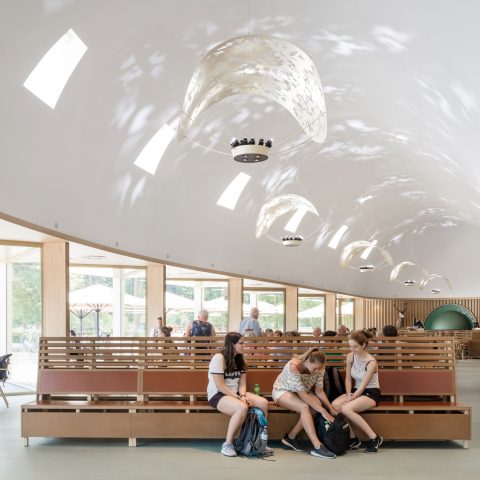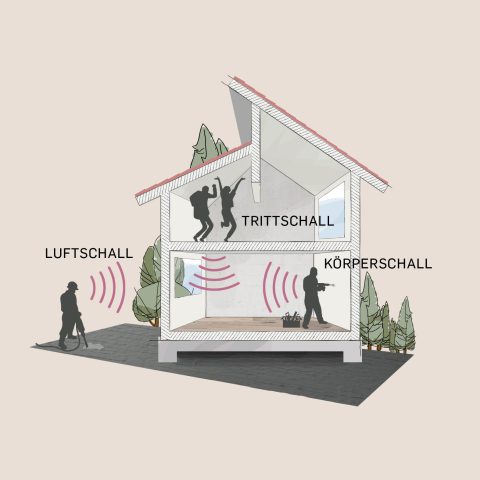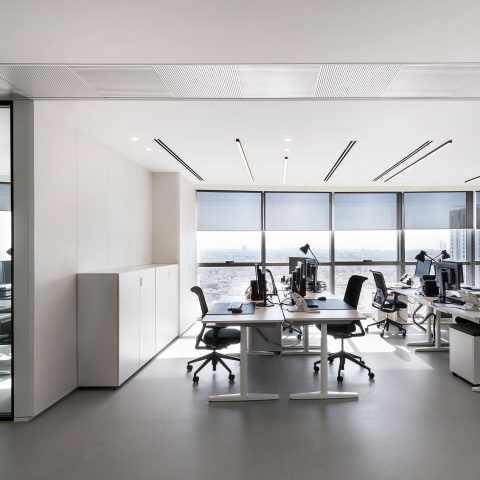Today, room acoustics play an important role in traditional performance and assembly venues as well as in everyday spaces. In addition to schools, restaurants, open-plan offices and shopping malls, more and more people are looking for the best possible hearing and sound experience in their own homes. Find out what you need to know about this topic and what room acoustic solutions are available.
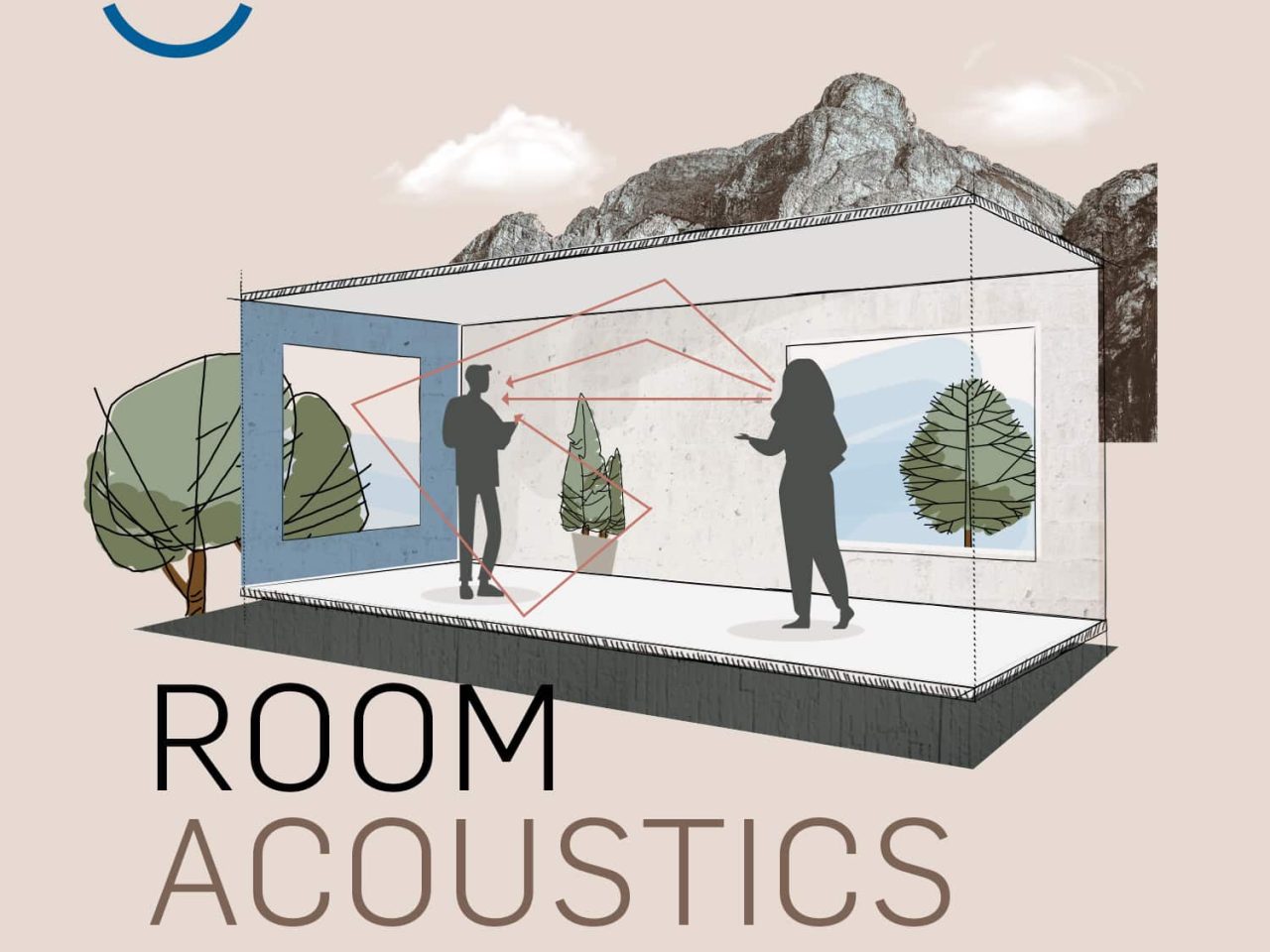
What are room acoustics?
Room acoustics refers to the acoustic properties of a room. When describing these properties, only the sound source within the room itself is taken into account.
Sound does not only propagate directly within a room. The sound waves emitted by a loudspeaker reach the listener partly as direct sound, but also via reflections from walls, ceilings or furniture. Each surface absorbs some of the incident sound. The reflections therefore gradually lose sound energy as the surface ‘swallows’ some of the energy by converting it into heat. The sound fades. The less absorption that takes place on the surfaces of the room, the longer this decay process lasts: the room sounds ‘reverberant’, it has a long reverberation time. Reverberant rooms have poor acoustic quality and are subjectively unpleasant for users. They are bad for speech intelligibility or the listening experience.
Room acoustic design has the following objectives, for example
- Optimum speech intelligibility in theatres, lecture halls and classrooms or meeting rooms.
- A subjectively pleasant listening experience in waiting rooms, restaurants or open-plan offices.
- A spatially and aesthetically pleasing musical experience in concert halls.
- In recording studios, the room itself should have as little influence as possible.
What influences room acoustics?
Room acoustics are strongly influenced by the size of the room, the geometry and the sound absorption of the room surfaces. For example, the low absorbency of smooth concrete walls can be compensated by the addition of absorptive surfaces.
In large rooms, to minimise reflections, it is advantageous to have absorption in more than one plane. For example, it is advisable to provide absorption on the ceiling and on another level. Without this measure, flutter echoes between parallel sound reflecting surfaces can occur.
Where very high demands are placed on the room acoustics, it is possible to use surface design in a targeted manner. This is done, for example, in soundproof booths with a large, highly absorptive surface.
What is the difference between room acoustics and building acoustics?
Whereas room acoustics is concerned with the propagation and distribution of sound in a room, building acoustics is concerned with the transmission of sound between two rooms or between the inside of a room and the outside. Building acoustics is concerned with phenomena such as airborne and impact sound, building services noise and external noise.
Measures against sound generation and sound transmission are also distinguished according to whether the sound source and the listener are in the same room or in different rooms. In the former case, sound control is achieved by sound absorption. In the latter case, it is achieved by sound insulation.
A distinction is made between airborne and structure-borne sound insulation. An important area of structure-borne sound insulation is the reduction of impact noise or the reduction of sanitary noise caused by fittings or piping. In the area of airborne sound insulation, walls and ceilings are often upgraded with cladding to form a double-shell system to significantly improve sound insulation.
Audibility in rooms: What is DIN 18041?
DIN 18041 is the internationally recognised standard for the design of room acoustics and is entitled: Acoustics in rooms – Requirements, recommendations and guidance for design. The standard specifies desirable reverberation times for rooms, depending on the volume of the room and the purpose of use. It also contains notes and sketches on the positioning and distribution of absorbers.
The standard for audibility in rooms aims to reduce noise and distinguishes between two groups of rooms, A and B. Uses for group A are music, speech, lecture, teaching and communication, and sports. For these types of use, the standard requires reverberation time to be considered as a function of frequency. Room group B includes rooms for short stays, such as entrance halls, corridors and stairwells, and rooms for longer stays, such as exhibition rooms, patient waiting rooms and break rooms or canteens. It also includes rooms where there is a need for noise reduction and comfort. For Room Group B, the standard provides specific guidance on the equivalent absorption area A in relation to the room volume V.
Sound absorption, reverberation time and reverberation
A number of terms and parameters are important for understanding room acoustics. Here are the most important basics.
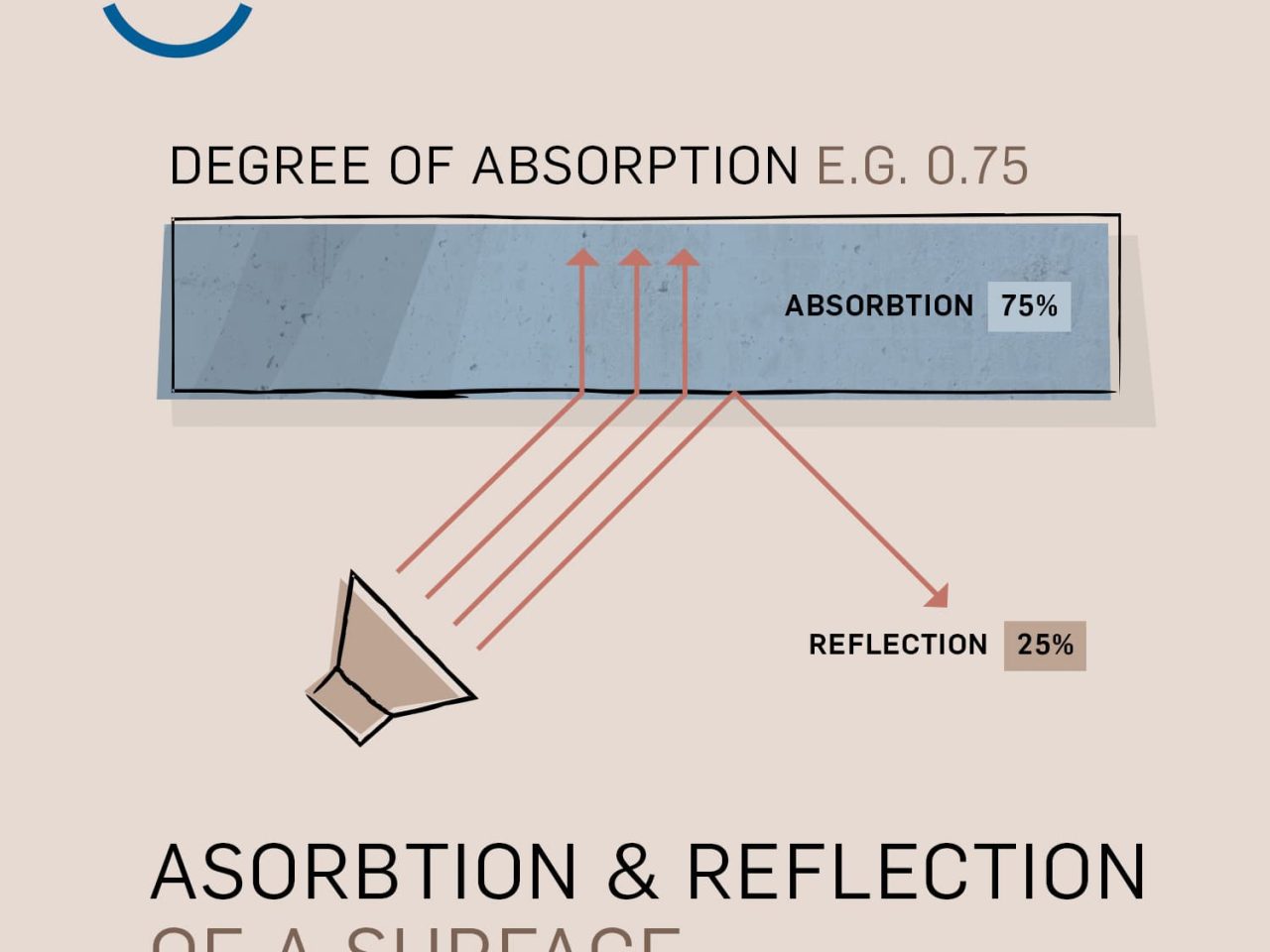
Sound Absorption
The sound absorption of surfaces varies greatly depending on their texture, material, and sound frequency. The harder and smoother the surface, the lower the sound absorption. Soft surfaces absorb a large portion of sound. Similarly, hard surfaces can also be absorbing if they are freely oscillating, hollow, thin plates.
The sound absorption coefficient ? is used as a measure of sound absorption, which represents the ratio of absorbed to incident sound energy. A value of ? = 0 means complete reflection, while ? = 1 represents complete absorption. The sound absorption coefficient also depends on the frequency. Therefore, it is common to represent ? in a diagram for precise representations. Many materials exhibit very different absorption behavior at certain frequencies. Usually, an absorption that covers a broad frequency range is required.
The use of the equivalent absorption area (A) is common in order to make a specific room acoustic statement about the absorption of individual wall surfaces. A in square meters indicates how small a wall surface could be if it were to absorb ideally. Therefore, the term “absorption capacity” is also common. The absorption capacity is related to the sound absorption coefficient (?) and the wall area (S):
A = ? · S
A simplified example that does not consider frequency-dependent differences illustrates the relationship. All three variants listed below bring the same amount of absorption into the room, namely A = 6 m²:
- An absorber with 12 m² absorber area S and ? = 0.5 results in an absorption capacity A of 0.5 · 12 = 6 m²
- The same absorption capacity is achieved with an absorber area of 7.5 m² and ? = 0.8
- Similarly, three ceiling panels with S = 2 m² each and ? = 1
In practice, the classification of acoustic elements according to DIN EN 11654 into absorber classes A, B, C, D, and E is established. It plays a decisive role in provider and product comparisons:
- Class A is highly absorbing and has a rated sound absorption coefficient ?w between 0.9 and 1.0
- Class E at the bottom of the classification has a rated sound absorption coefficient ?w between 0.15 and 0.25
The choice of class depends on the acoustic requirements of a room, as the existing sound absorption in the room is supplemented in a frequency-dependent manner with the materials of the different absorber classes.
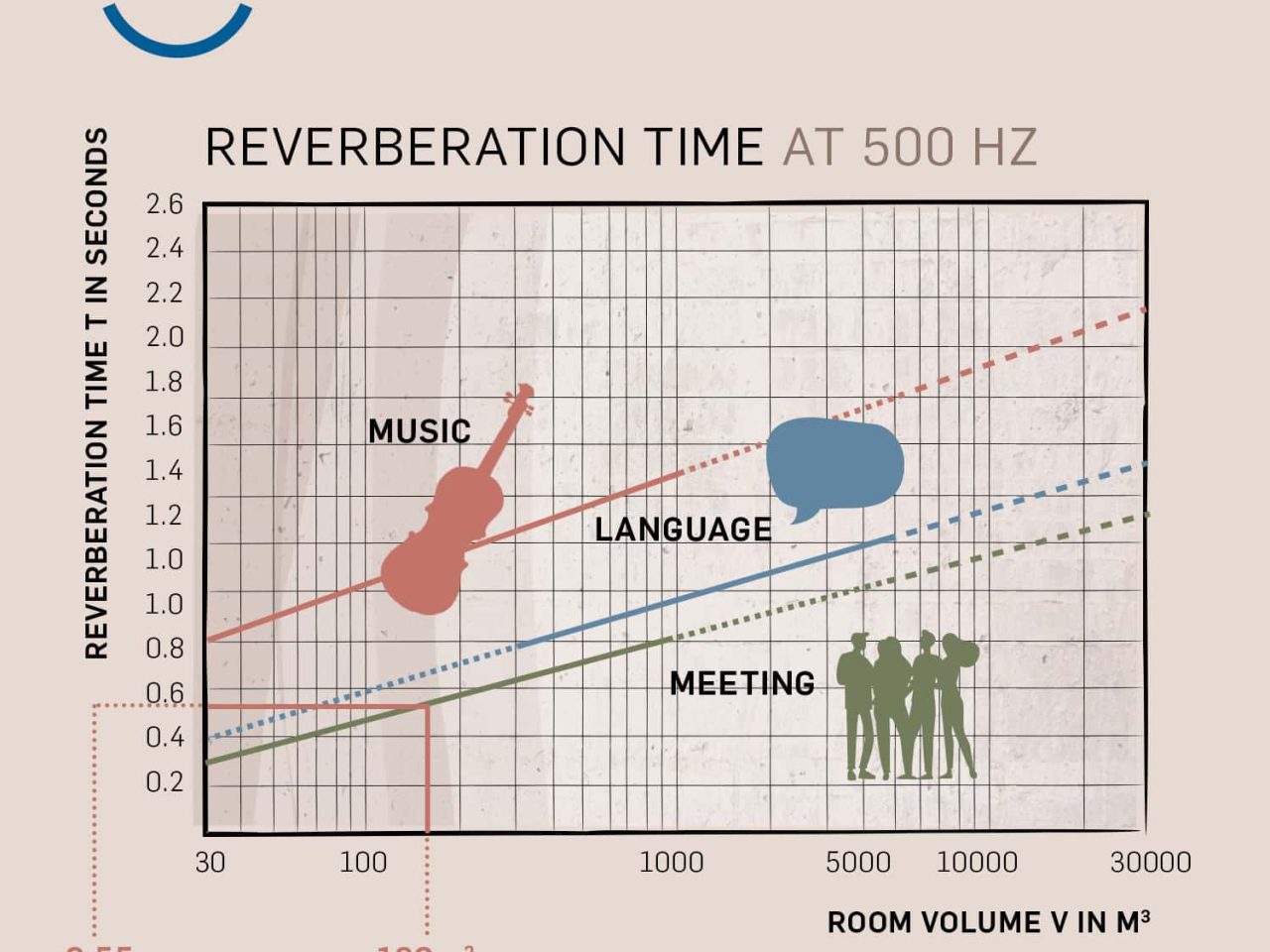
Reverberation Time
The most important parameter in room acoustics is the reverberation time (T) of a room. The reverberation time is the time in seconds it takes for the sound pressure in a room to decay to 1/1000 of its initial value after the sound source has been abruptly silenced. This corresponds to a decrease in sound pressure level of 60 dB. In the early 20th century, the American physicist Wallace Clement Sabine discovered that the reverberation time, room volume, and sound absorption of the room’s surfaces are interrelated: the larger the room volume (V) and the lower the absorption (A), the longer the reverberation time. The “Sabine formula” expresses this relationship:
T = 0.163 · V / A
In practice, rooms with low absorption sound “echoey” and are perceived acoustically as uncomfortable. Desired reverberation times depend on the intended use and the size of the room. Good average reverberation times for speech are around 1 second, while for symphonic music they are about 2 seconds. When planning multi-purpose halls, the reverberation time should be adjusted to the intended main use of the space.
By varying the absorption surface, the desired reverberation time can be adjusted depending on the frequency range. It is important to consider all other surfaces and materials, as well as the number of people in the room, as they also affect sound absorption. Therefore, when planning, it should be considered what the final room will look like.
For rooms with conventional use such as classrooms, open-plan offices, waiting rooms or multi-functional areas, there is a widely used rule of thumb that good reverberation times can be achieved by equipping an area corresponding to the room footprint with an effective sound absorber. For rooms with demanding use or very high ceilings, a specialist planner should be consulted to ensure good reverberation times.
Reverberation and Clarity
Reverberation describes the perception of an auditory event in which direct sound and reflected room sound are present. The reflected sound, however, is not perceived as a repetition of the sound signal. Reverberation depends on the ratio of the late arriving sound level to the early parts. In speech, this applies to time differences of 50 ms or more, and in music, it applies to time differences of about 80 ms.
A reverberant listening experience in practice reduces speech intelligibility. In music, however, the effect is a “blending” listening experience with reduced “transparency”, which is perceived as positive up to a certain volume.
Structure-borne and Airborne Sound
Airborne sound is familiar to us all. Structure-borne sound is a term used in building physics to describe the propagation of sound waves in solid objects. In sound propagation in buildings, structure-borne sound plays a non-negligible role.
Direct and converted structure-borne sound can be distinguished:
- Direct structure-borne sound: Mechanical vibrations on a body lead to structure-borne vibrations. The vibrations of a hammer drill are transmitted directly to the wall.
- Converted structure-borne sound: Airborne sound is converted into structure-borne sound. At the transition between air and solid body, for example, at the wall of a room, several physical phenomena occur. Part of the airborne sound waves are reflected, creating room sound. Another part is absorbed by the wall surface, producing heat energy. A third component of the airborne sound waves causes the wall itself to vibrate. Structure-borne sound is created when the sound source is strong enough. For example, in a loud music system, a portion of the airborne sound is converted into structure-borne sound. The resulting structure-borne sound is transmitted through the solid wall structure in the form of structure-borne vibrations.
Another form of direct structure-borne sound is impact noise. This is created when walking on a floor or stairs.
We humans cannot hear structure-borne sound, but we can feel it. The loud bass of a techno music track, for example, creates strong airborne sound waves that hit our body and trigger structure-borne sound in the human body, which is also clearly perceptible in the form of vibrations.
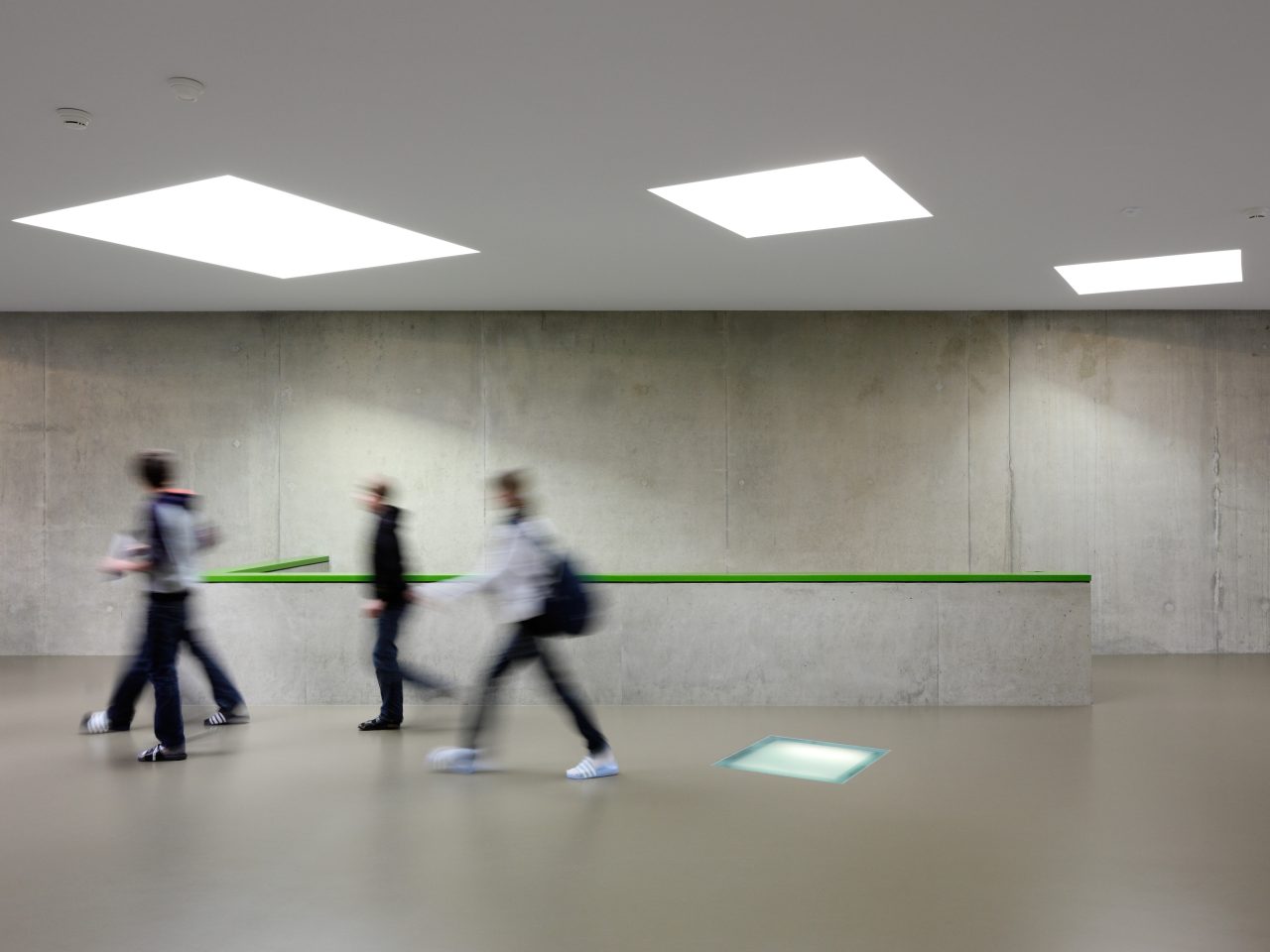
How can room acoustics be improved?
Improving room acoustics usually requires a combination of measures. Modern architecture is often characterised by large rooms and materials with smooth surfaces, such as plastic, glass or concrete. As a result, room acoustics and speech intelligibility are severely compromised.
In order to combine aesthetically pleasing modern architecture with good room acoustics, flexible and individual acoustic elements are required that enhance the room design and blend seamlessly and discreetly into the existing architecture.
Improving room acoustics has the following positive effects:
- Absorption and redirection of early reflections: Initial reflections are those sound vibrations that hit a wall first and are reflected back to the ear. They can cause cancellation or overemphasis in a particular frequency range, i.e. interference. Initial reflections occur on walls, ceilings and floors.
- Adjusting the reverberation time: While a good reverberation time for meeting rooms is about 1 s as a guide, the value for musical performances is about 2 s, and a value of 0.25 to 0.3 s is established for control rooms.
In order to create an optimal room acoustic situation, the expert usually proceeds as follows:
- Carry out a needs analysis based on the dimensions and volume of the room, the furnishings and the intended use of the room
- The individual requirements are determined by means of an acoustic calculation
- Determine the position and size of the required sound absorbers
- Placement of several sound absorbers on surfaces close to speech sources
- Optional plants, carpets and curtains to complete the individual concept

What are the room acoustic solutions available?
Measures for optimizing room acoustics can be carried out during the construction project or afterwards. There are several options for optimizing room acoustics:
- Acoustic carrier panels with BASWA’s fine marble sand acoustic plaster for seamless acoustic solutions are executed smooth, colorful, curved or thermally activated and are very discreet and seamlessly integrated into the architecture. With a thermally activated execution, it is possible to combine a thermo-active building system (TAB system) with an acoustically effective ceiling
- Ceiling panels are mounted with distance to the ceiling for maximum sound absorption. Holes in the ceiling are required for the installation of the panels. For buildings under historic protection, this can be a problem
- Ceiling panels are either glued or mounted
- Sound-absorbing wall panels are directly attached to existing walls. For optimal visual integration, a selection of colors and image motifs is available. There are also absorbers with pinboard function available
- Acoustic foam panels are usually made of polyurethane foam. The foam panels are typically used for reducing echo and reverb in a room
- Acoustic frames with perforated plates
- Acoustic room dividers and partitions
- Tabletop absorbers
- Acoustic pictures
When selecting products for sound absorption, some additional aspects should be considered:
- Are the materials environmentally safe?
- Are the materials suitable for allergy sufferers?
- Are the products flame retardant or do they have a fire protection?

